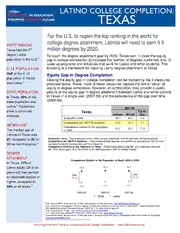
ERIC ED532156: Latino College Completion: Texas PDF
Preview ERIC ED532156: Latino College Completion: Texas
LATINO COLLEGE COMPLETION: TEXAS For the U.S. to regain the top ranking in the world for college degree attainment, Latinos will need to earn 5.5 STATE RANKING Texas had the 2nd million degrees by 2020. largest Latino To reach the degree attainment goal by 2020, Texas can: 1) close the equity population in the U.S.1 gap in college completion; 2) increase the number of degrees conferred; and, 3) scale up programs and initiatives that work for Latino and other students. The K-12 POPULATION following is a framework for tracking Latino degree attainment in Texas. Half of the K-12 Equity Gap in Degree Completion population in Texas C losing the equity gap in college completion can be tracked by the 3 measures was Latino.2 provided below. Alone, none of these measures capture the entire “story” of equity in degree completion. However, in combination, they provide a useful STATE POPULATION picture of the equity gap in degree attainment between Latino and white cohorts in Texas in a single year (2007-08) and the persistence of the gap over time In Texas, 38% of the (2006-08). state population was Latino.3 Projections 2007-08 show a continued Texas Equity Latinos Whites Gap increase. Graduation rates 29.7 39.6 9.9 Completions per 100 FTE students 15.0 16.7 1.7 MEDIAN AGE Completions relative to the population 13.7 34.7 21.0 The median age of in need Latinos in Texas was 27, compared to 35 for Graduation rates - Total graduation within 150% percent of program time for first-time, full-time freshman Completions per 100 FTE students – Total undergraduate degrees and certificates awarded per 100 full-time White non-Hispanics.4 equivalent students (incorporates part-time students) Completions Relative to the Population in Need – Total undergraduate degrees and certificates awarded per 1,000 adults aged 18 to 44 relative to the adult population with no college degree DEGREE ATTAINMENT Completions Relative to the Population in Need: 2006 to 2008 In Texas, 17% of Latino adults (25 to 64 33.9 35.2 34.7 years old) had earned Gap: Gap: an associate degree or 21.5 21.0 higher, compared to 34% of all adults.5 12.4 13.4 13.7 2005-06 2006-07 2007-08 White Latino 1 U.S. Census 2010, American Fact Finder, Demographic Profile Summary. http://factfinder2.census.gov 2 U.S. Department of Education, National Center for Education Statistics, Common Core of Data (CCD), "State Nonfiscal Public Elementary/Secondary Education Survey", 2009-10, v.1b. www.nces.ed.gov/ccd 3 U.S. Census 2010: Texas. http://2010.census.gov/2010census/data/ 4 U.S. Census Bureau, 2006-2010 American Community Survey. www.census.gov/acs 5 Lumina Foundation for Education. A Stronger Nation Through Higher Education. Educational Attainment Levels for the States. www.luminafoundation.org Ensuring America’s Future by Increasing Latin o College Completion • www.EdExcelencia.org Degrees Conferred Another metric to benchmark college completion is to track the progress of total degrees awarded over time. This measure may be the result of an increase in overall enrollment numbers rather than an increase in rates of completion. From 2005-06 to 2007-08, • the number of Hispanics who earned an undergraduate degree in Texas increased about 7% from 2006-08, while all other race/ethnic groups increased 4%. • Texas had one of the largest increases in degrees conferred to Latinos over 3 years among the top 10 states enrolling Latinos. For more information on these metrics, download Benchmarking Latino College Completion to Meet National Goals: 2010 to 2020 and Degrees Conferred to Latinos: 2006-2008 at www.EdExcelencia.org/research/EAF/Benchmarking Examples of What Works for Latino Students There are institutions in Texas showing success in enrolling, retaining, and graduating Latino students. The following are examples of institutional programs with evidence of effectiveness in serving Latino students nominated for Examples of Excelencia. Dual Enrollment Program - The University of Texas Brownsville and Texas Southmost College The University of Texas Brownsville offers a dual enrollment program that enables high school students who meet institutional and course-based admissions requirements to receive simultaneous credit for high school level and college level classes. In fall 2007, dual enrollment population accounted for approximately one-third of the UTB total enrollment of 17,215 and represented 18 South Texas high schools. Further, these students had higher retention rates than other students at the University. The one-year retention rate for college students who were former dual enrollment students was 73 percent, compared to 59 percent for non-dual enrollment students. (http://www.utb.edu/vpaa/dual/Pages) Model Institutions for Excellence (MIE) - University of Texas at El Paso The program’s goal is to increase participation and success of underrepresented minority students, especially Latinos, obtaining degrees in science, technology, engineering, and mathematics (STEM) fields at UTEP. For the 1999-2000 academic year, 219 STEM degrees were awarded to Latino students (289 overall) and for the 2004-2005 academic year, 374 STEM degrees were awarded to Latino students (440 overall). (http://research.utep.edu/mie) For more information on institutional programs improving Latino student success in higher education, access Excelencia in Education’s Growing What Works database at http://www.edexcelencia.org/examples Ensuring America’s Future partners in Texas: Greater Texas Foundation: www.greatertexasfoundation.org/ Hispanic Association of Colleges and Universities: www.hacu.net Intercultural Development Research Association: www.idra.org Project Grad USA: www.projectgrad.org Texas House of Representatives, Representative Joaquin Castro: http://www.house.state.tx.us/members/member-page/?district=125 TG: www.tgslc.org University of Texas at Brownsville and Texas Southmost College: www.utb.edu University of Texas at El Paso: www.utep.edu University of Texas System: www.utsystem.edu Ensuring America’s Future by Increasing Latin o College Completion • www.EdExcelencia.org
